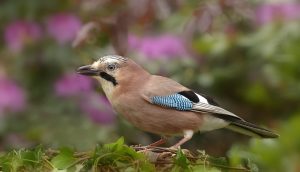Jays are the brightest coloured of the crow family. They are easily identified by their pink plumage, the flash of brilliant blue on their wings and their funny-looking moustache.
They live in deciduous and coniferous woodland where they are more often heard before they are seen. Jays fly overhead, letting out loud screeches as they go.
They are prevalent across all of Britain, other than northern Scotland, and are most likely spotted in autumn.
I wondered if this was anything to do with their diet, so investigated, exactly, what do jays eat?

As my mum would have said, jays stomachs are like bottomless pits! They have voracious appetites and happily dine on a wide range of foods.
However, there is one item that jays sell their souls to the devil for; acorns.
They search far and wide on the hunt for them, especially during the autumn when oak trees are heavily laden.
Jays also feed on garden tables; peanuts are their absolute favourites. They are omnivorous and are also partial to mealworms.
Table of Contents
Jays and their relationship with acorns
It is during the autumn that jays become their most active, searching for acorns.
Instead of eating their source immediately, the clever birds squirrel them away in a secret cache.
Their hiding spots include naturally-formed holes, beneath leaf litter, and in crevices in tree bark. They take note of close features to ensure they find their store when winter comes. Jays will use their strong bill to dig down if the acorns have become buried beneath mud or snow.
It’s fine if they don’t find every hidden acorn as they lay dormant before attempting germination in the spring.
Gathering acorns is a full-time job in autumn jays fly great distances and spend up to 10-hours per day stashing their collection.
They can fit 9 acorns in their gullet at any one time but usually carry 2 or 3 and 1 in their beak.
It is believed that each jay collects around 5000 acorns each season. Each one is packed with calories and healthy oils to prepare the birds for the hardships of winter.
What do jays eat in the wild
Other than acorns, jays eat nuts, seeds, fruits, and insects. They are predatory and plunder the nests of different birds to eat their eggs or nestlings.
They are resourceful birds, changing their diet as needs dictate. This allows them to feast on small mammals from time to time. Bats, newts, and small rodents are some of their favourites.
What to feed jays in the garden
If you don’t have a flourishing oak tree in your garden (and who does) there are still ways to attract jays.
They are very fond of peanuts and munch their way through their own bodyweight if left in peace.
They are comfortable using hanging feeders all year round although I prefer to scatter them on a bird table in autumn and winter.
Although jays have no difficulty with whole peanuts, I still prefer to offer crushed ones; just to prevent choking hazards with any of the smaller birds.
Jays also love mealworms; live ones are best. If you only have dried ones, soak them overnight before putting them out.
I have a visiting jay who makes a beeline for nyjer seeds if there are no peanut available.
Remember to always have fresh water available, especially in the winter when ponds freeze. Dried foods can quickly dehydrate birds; they need to drink plenty.
Final thoughts
Jays have insatiable appetites and choose to spend most of their time hunting for food or burying it for later use.
Knowing what jays eat can encourage them to dine at your feeding stations. Beware, they have a reputation for being greedy and will eat you out of house and home!
